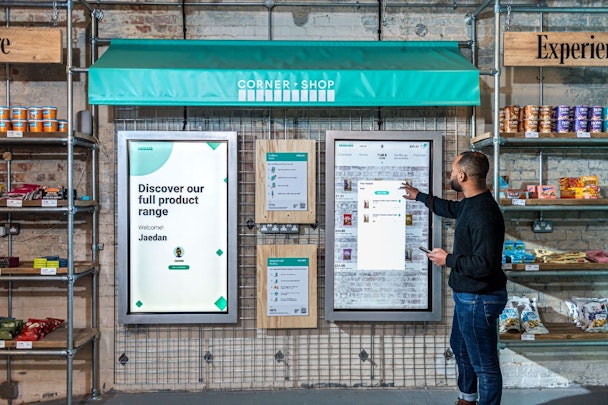Behind the future of retail: reimagining connected commerce experiences in retail 5.0
Digital disruption and tech advancements have accelerated the need for connected, omnichannel retail experiences, but what shifts must brands make to innovate and keep pace?

We’ve reached the fifth generation of retail and e-commerce - meet retail 5.0
The traditional online marketing and sales funnel has evolved beyond all recognition. Linear shopping journeys are no longer relevant; instead, consumers are navigating between physical and digital touchpoints and they expect everything to be personalized and shoppable. That starts with the content that inspires them and connects seamlessly throughout their journey to the point-of-purchase.
Commerce has become the orchestrator enabling the path to purchase and conversions, closing the gap between marketing and sales. It is imperative for brands and retailers to ensure they are staying relevant and providing valuable experiences at all stages of the journey through a connected customer experience that is seamless and frictionless, hyper-personalized and omnichannel.
Relevance is key. After all, research from Frog, part of Capgemini Invent, shows that nine-in-10 shoppers expect consistent interactions with brands across channels, but only a minority (less than 6%) say they find their shopping experiences to always be relevant. A lack of personalized content is stopping an overwhelming majority from making a purchase.
Explore frequently asked questions
We’ve reached the fifth generation of retail and e-commerce (dubbed retail 5.0) – a landscape characterized by mass personalization at scale and shaped by an omnichannel approach where e-commerce platforms co-exist alongside physical touchpoints.
“Fifth-generation retail is the evolution to ‘consumption-centric’, using real-time data to maximize performance and minimize waste,” explains Steve Hewett, the vice-president and customer transformation and CX tech leader at Frog. “For brands, this is an opportunity to take advantage of always-on connectivity to engage directly at scale with their consumers.”
A human-centered approach
For brands and businesses to thrive in this retail landscape, they must stay relevant. But for many, that means fundamentally having to rethink their capabilities and adopt agile operating models to meet the evolving needs and expectations of consumers and customers in this new world.
A human, customer-centric approach to end-to-end commerce will be key for brands to succeed. By truly understanding the customer proposition and getting the front-end engagement right, brands will be better positioned to connect the dots across channels.
That puts the focus on consumer behavior insights and market data – underpinned and enabled by tech – to reimagine the commerce experience with new ways to give customers what they want. By capturing and analyzing data to understand customer preferences and values, brands can apply those insights to unlock entirely new revenue streams and identify new paths to growth.
Advertisement
Closing the gap
Omnichannel is everywhere. Adopting digital-first is the tipping point as businesses deliver at speed, providing transparency and convenience. Retail today is borderless and should be available anywhere, anytime.
Research shows that 93% of shoppers expect their digital experience to be equal to or better than in-store. Today, the store is the media, the media is the store. The unique opportunity for brands is to look at the future of store systems and put in place a capability that is fit for tomorrow, to drive a true online-to-offline, omnichannel experience, explains Hewett.
But to keep pace with these rising consumer expectations, there are some key internal challenges businesses must overcome to drive forward this shift. These include adapting business models to weather market disruption; adopting a digital-first approach and doing more with less; accelerating sustainability-driven investments; assessing the omnichannel CX experience strategy beyond delivering e-commerce and driving continuous innovation, efficiency and improvements; and activating and operating in complex ‘glocal’ markets.
Advertisement
Towards unified commerce
Moving forward in this new world, a unified approach to commerce will be key for brands to thrive. To drive this shift to connected commerce experiences, consider the following tips:
-
Establish personal relationships: make personalized offers, improved recommendations and incentives for customers to share their data to drive more relevant conversions and spend.
-
Offer more connected platforms: enable your customers to choose and switch seamlessly across touchpoints, sharing real-time data for simple one-touch experiences where it suits.
-
Create valuable experiences: share inspirational, educational content, enhance product searches and information to enable their purchase decisions by driving value.
-
Give them flexible, convenient choices: offer same-day, precise windows with competitive core items, instant delivery to meet immediate and unplanned needs.
-
Help them do good for the planet: adapt the brand image, culture, products and services to meet the changing emotional values of customers… at the right price.
To explore how the most progressive brands are creating market-shifting retail initiatives to re-imagine the connected commerce experience, check out the other articles in this series below:
- Direct Commerce – a spotlight on CPG/Fashion
- Commerce Unleashed – a spotlight on Grocery
- Commerce Transformed – a spotlight on Automotive
Suggested newsletters for you
Content created with:

Capgemini
Capgemini is a global leader in partnering with companies to transform and manage their business by harnessing the power of technology. The Group is guided everyday...
Find out more
